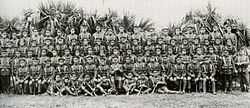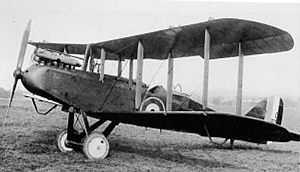Arthur Spurling
| Arthur Rowe Spurling | |
|---|---|
| Born |
19 May 1896 Bermuda |
| Died |
1984 Guernsey |
| Allegiance |
|
| Service/branch | Aviation |
| Years of service | 1915-1919 1939-1945 |
| Rank | Squadron Leader |
| Unit |
|
| Awards | Distinguished Flying Cross |
Squadron Leader Arthur Rowe Spurling was a Bermudian who served during the First World War as an infantryman and an aviator, becoming an ace credited with six aerial victories,[1] and as a ferry pilot during the Second World War.
Rowe Spurling was born into a prominent Bermudian family in Hamilton, in the British colony of Bermuda, on 19 May 1896.
First World War
When the UK declared war on the Central Powers in August 1914, the part-time volunteer army units in Bermuda, the Bermuda Volunteer Rifle Corps (BVRC) and the Bermuda Militia Artillery (BMA), were mobilised. Although required to fulfil their roles as parts of the Bermuda Garrison, both units immediately proposed sending drafts to the Western Front. The BVRC quickly formed a detachment in December 1914, which was to train in Bermuda over the winter before being dispatched across the Atlantic. This contingent was composed of volunteers who were already serving, as well as those who enlisted specifically for the Front. Rowe volunteered for the contingent in February 1915. The Contingent trained at Warwick Camp through the winter and Spring. It consisted of Captain Richard Tucker and eighty-eight other ranks.[2]
The Contingent left Bermuda for England on 7 May 1915, travelling to Canada, then crossing the Atlantic in company with a much larger Canadian draft. It had been hoped that the Contingent could be attached to the Second Battalion of The Lincolnshire Regiment (2 Lincolns), which had been on Garrison in Bermuda when the War began. When the Contingent arrived at the Lincolns depot in Grimsby, the 2nd Battalion was already in France and it was attached to 1 Lincolns, instead. Captain Tucker carried written instructions from the War Office that ensured that they remained together as a unit, under their own badge. Despite this, the riflemen were given regimental numbers by the Lincolns, Spurling's being 3/17150 (his old BVRC number was 989).[3]
The contingent arrived in France on 23 June, the first colonial volunteer unit to reach the Front, as an extra company attached to 1 Lincolns, and remained as such til the following summer, by when its strength had been too reduced by casualties to compose a full company, having lost 50% of its remaining strength at Gueudecourt on 25 September 1916. The survivors were merged on 17 October 1916, with the thirty-three men of a Second Contingent of the BVRC, newly arrived from Bermuda, and all were retrained as Lewis gunners.[4]

Rifleman Spurling was twice wounded in 1916: in the hand on 3 July, and in the foot on 13 July (when he reported he was also buried for a few hours). In July 1917, he received a commission, one of sixteen BVRC enlisted men who would become officers while serving in France. Newly commissioned officers were not obliged to return to their original units, but could choose to join any of the regiments or corps of the British Army. Spurling was one of two who chose to join the Royal Flying Corps (RFC), the air arm of the British Army (the other was Henry Joseph Watlington [5][6]), although more than a dozen other Bermudians would reach the RFC by different routes (including another BVRC rifleman, later Major Cecil Montgomery-Moore, who detached from the Corps in Bermuda, and who also earned the DFC in France), and 2/Lt. Lennock de Graaf Godet, who had left his studies at Oxford University with the declaration of war.[7]

Lieutenant Spurling trained as a pilot, and was posted to 49 Squadron in July 1918, flying the DeHavilland DH9, a light bomber with two crew members (a pilot and an observer, who doubled as a defensive gunner). By then, the Royal Flying Corps no longer existed, it having been merged with the Royal Naval Air Service on 1 April 1918 to create the independent Royal Air Force (RAF), to which service Spurling now belonged.
On 23 August 1918, Spurling was flying on a bombing mission when he became separated from his formation. Thinking he was over the British lines, he prepared to land on a German airfield near Lens which he mistook for his own, but was attacked by a German Fokker D.VII fighter. He then saw a formation of thirty more Fokkers. Despite the disadvantages of his flying a bomber and being vastly outnumbered, Spurling launched an attack, shooting down three of the German aircraft, while Sgt. Bell, his observer and tail gunner, accounted for two more. Sharing Bell's kills, these five victories immediately made Spurling an ace. It was for this action that Spurling was awarded the DFC and Sgt Bell was awarded the DFM. Two days later Spurling shot down another D.VII over Mont Notre Dame.[8][9][10]
Second World War
After the First World War, Rowe returned to civil life in Bermuda. During the Second World War, he returned to the RAF, reaching the rank of Squadron Leader. He served in RAF Transport Command, which was, among other things, responsible for trans-Atlantic delivery of cargo and personnel. This was one of two RAF commands operating in Bermuda (from RAF Darrell's Island, and Kindley Field), which had been an important staging point since the start of trans-Atlantic aviation. During this war, Spurling was credited with identifying a Nazi spy in Canada.
Post-War
After the Second World War, Spurling returned again to civilian life. He married in 1948 to Ilys Darrell, and operated a taxi fleet and the Rowe Spurling Paint Company Ltd, which still exists.[11]
Rowe and Ilys moved to Guernsey in the 1970s. They planned to return to Bermuda, but he developed Alzheimer's disease, and died in England in 1984. His body was returned to Bermuda for burial.
References
- ↑ http://www.theaerodrome.com/aces/england/spurling.php
- ↑ Defence, Not Defiance: A History Of The Bermuda Volunteer Rifle Corps, Jennifer M. Ingham (now Jennifer M. Hind), The Island Press Ltd., Pembroke, Bermuda,, ISBN 0-9696517-1-6
- ↑ B.V.R.C. Contingent: Change in Regimental Numbers, The Royal Gazette and Colonist Daily (now The Royal Gazette), Hamilton, Bermuda. 10 July 1915.
- ↑ The History of The Lincolnshire Regiment: 1914-1918, Edited by Major-General C.R. Simpson, C.B. The Medici Society, London. 1931.
- ↑ A short study of Henry Joseph Watlington Lieutenant R.F.C. with letters from the Front The First World War, Page 105, Watlington Family Narrative, by Hereward T. Watlington. Printed and bound in Canada by The Hunter Rose Company Ltd
- ↑ POTSI (archived): H. Joe Watlington
- ↑ POTSI (archived): 2/LT Lennock De Graaf Godet
- ↑ The Aerodrome: Arthur Rowe Spurling
- ↑ Lt. Spurling Won Flying Cross, . The Royal Gazette and Colonist Daily (now The Royal Gazette), Hamilton, Bermuda. 19 September 1918.
- ↑ POTSI (archived): Sqn. Ldr. A. Rowe Spurling, DFC
- ↑ Rowe Spurling Paint Company Ltd
Bibliography
- Defence, Not Defiance: A History Of The Bermuda Volunteer Rifle Corps, Jennifer M. Ingham (now Jennifer M. Hind), The Island Press Ltd., Pembroke, Bermuda, ISBN 0-9696517-1-6
- The History of The Lincolnshire Regiment: 1914-1918, Edited by Major-General C.R. Simpson, C.B. The Medici Society, London. 1931.
- The Andrew And The Onions: The Story Of The Royal Navy In Bermuda, 1795–1975, Lt. Commander Ian Strannack, The Bermuda Maritime Museum Press, The Bermuda Maritime Museum, P.O. Box MA 133, Mangrove Bay, Bermuda MA BX. ISBN 0-921560-03-6
- Bermuda Forts 1612–1957, Dr. Edward C. Harris, The Bermuda Maritime Museum Press, The Bermuda Maritime Museum, ISBN 0-921560-11-7
- Bulwark Of Empire: Bermuda's Fortified Naval Base 1860-1920, Lt.-Col. Roger Willock, USMC, The Bermuda Maritime Museum Press, The Bermuda Maritime Museum, ISBN 0-921560-00-1
- That's My Bloody Plane, by Major Cecil Montgomery-Moore, DFC, and Peter Kilduff. 1975. The Pequot Press, Chester, Connecticut. ISBN 0-87106-057-4.
External links
- The Royal Gazette: An audacious attack
- The Royal Gazette: Hero's medals up for auction
- The Royal Gazette: Bermudian's Great War medal quadruples auction expectation
- Rowe Spurling Paint Company Ltd